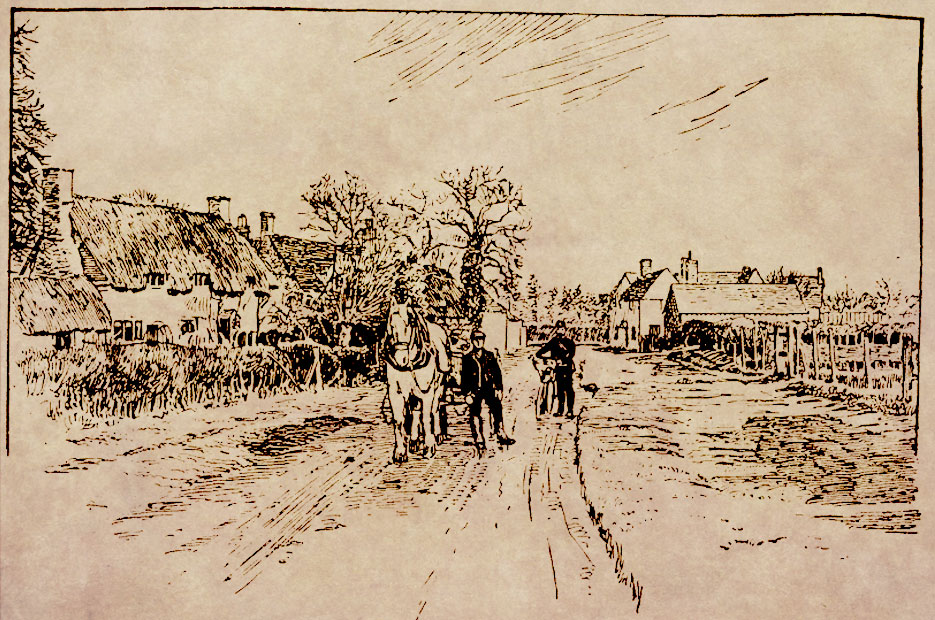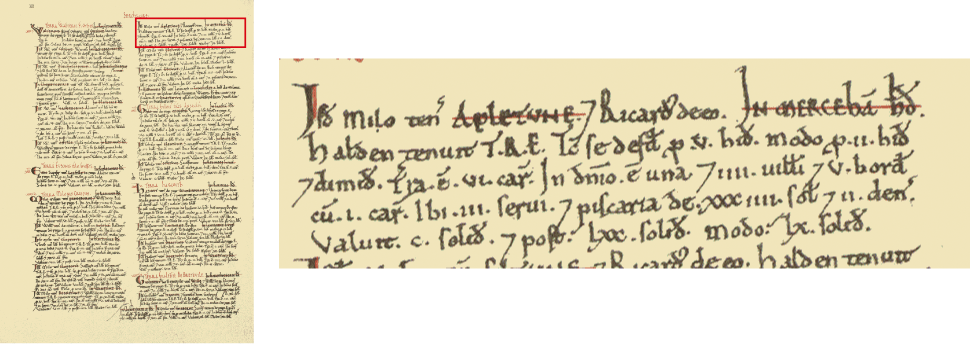History of Appleton with Eaton

What’s in a Name?
Most village names in Oxfordshire were recorded for the first time in the Domesday Book of 1086. However, Appleton has an earlier pedigree and first appeared as Aeppeltune in a charter of King Edgar ‘the Industrious’ in 942. The name was probably in use even before that. A charter of King Ine of the West Saxons dating from 687 records an area called Aearomundeslee, which covered Appleton, Eaton and Bessels Leigh. These three settlements formed the core of an ancient estate that could have originated in the Roman era. It was probably attached to the recently excavated Romano-British settlement at Marcham.
In the Domesday Book our village is called Apletone and after that it appears as Apeltun in 1218, Eppelton in 1220, Aspelton in 1316, Appulton in 1369 and even Appyltone in 1531.
As you might guess the place-name meaning is fairly straightforward – the tun (farm or hamlet) where apples grow, but place-name historians think the apple in this context actually means ‘orchard’.
Up until the Norman Conquest Appleton was a royal manor, which the Domesday Book tells us was partly owned by King Edward the Confessor. After the Conquest it was given to two Norman magnates, Miles Crispin, the first governor of Wallingford Castle and William the Conqueror’s half-brother Odo, Bishop of Bayeux. Odo was the richest man in Norman England, apart from the king, and owned extensive estates in Oxfordshire, but Appleton was the only land he held in Berkshire.
Appleton village was badly damaged by marauding Norman armies after the Battle of Hastings. This destruction is reflected in the village’s values, which are recorded in the Domesday Book, in 1066 it was worth 180 shillings compared to 1086, when it was only worth 110 shillings. Among the other items recorded for the village are six slaves and a fishery worth 34 shillings 2d., which would have been sited on the River Thames.

Note about Trevor Rowley
Trevor, and his wife Jane, have lived in Appleton for many years and Trevor has written and has had published several books which can be found at alibris.co.uk and and on amazon.co.uk.
Trevor’s book, The Man Behind the Bayeux Tapestry: Odo, William the Conqueror’s Half-Brother, was published by The History Press on the 15th March 2013. The ISBN number is 9780752460253.
His latest book is The Archaeology of the Bayeux Tapestry, published by Pen and Sword in 2016. He has another book with the same publishers, Landscapes of the Norman Conquest, coming out in September 2022.
14th April 2014: The Oxford Mail featured an article about Roger Sweet who took on the task of visiting and taking photographs of every village in Oxfordshire! See Roger Sweet: Oxford Mail for the Oxford Mail article and Appleton and Eaton: a record. Apart from the sad photograph of the Thatched Tavern being “de-commissioned” a good reflection?
To contact Trevor Rowley, email; richardtrevor.rowley@gmail.com
The piece below appeared in the front of the 1998 “Appleton with Eaton Parish Appraisal”.
Appleton
Appleton (known in charters by various forms of that name meaning simply “an orchard” and also as Earmundesleah) has had a fairly uneventful history. The existence of a tumulus known as Yttings Hlaw (or similar spellings) indicates early settlement, and the presence of Bad’s Well, with its alleged healing properties especially for eyes, may have given the area some fame before the Conquest.
The most traumatic event in the village’s history was probably its occupation by the Danes in 871 when they sacked Abingdon Abbey, which owned it. It is assumed that it was recovered by Alfred the Great and in 942 King Edmund (hence the non Appleton form of the name) granted it to one Athelstan, who may have restored it to Abingdon Abbey.
The parish appears in the Doomsday Book, notably as the site of the most valuable fishery in Berkshire worth £1.4s.2d. From then on the history is largely a record of grants and reversions, the best-known names to appear in the list of grantors and or tenants being William de Merton, perhaps a kinsman of the founder of Merton College, Oxford, Sir William de Shareshill, Lord Chief Justice in the reign of Edward III, and William Lenthall, Speaker of the Long Parliament (this at a time when the Lordship of the Manor descended with that of Besselsleigh) and – of more local fame – the Fettiplaces and the Southbys.
Eaton
Eaton, too, was famous for its fisheries in 1086 and, unlike Appleton, appears never to have been a possession of Abingdon Abbey. Oddly, the lordship of Eaton seems to have been more connected in medieval times with Cumnor and even with Fyfield than with Appleton.
The civil parish of Appleton-with-Eaton was created in 1894 and in 1974, together with the rest of north Berkshire, the parish was transferred to Oxfordshire.
Eaton (meaning land by a river) is mainly a farming hamlet. It received its Charter in 968 from King Edgar, and in 1968 enjoyable millennium celebrations took place in which all residents, their families and ex-residents took part.
In 1554 Eaton Manor and lands were conveyed by Christopher and Catherine Ashton to Sir Thomas White, who founded St John’s College, and so they became college property. The Sellwood family lived in a house in the hamlet from 1569 to 1840, and their annual rent to St John’s included 14 shillings, I peck of malt, 2 bushels of oats and 2 hens.
Originally Eaton was sited lower down the hill towards Bablockhythe and the Isis/Thames but moved to its present position, it is believed, due to the Black Death. Coal and goods were transported up from the river to the public house at one time.
The hamlet was enclosed in 1828 to 1830 when the roads to Appleton and Cumnor were altered, and the road from the river curved round in front of The Eight Bells instead of Manor Farm.
The soil is Oxford Clay with Corellian beds underneath.
For further information see on line Appleton History from British History
